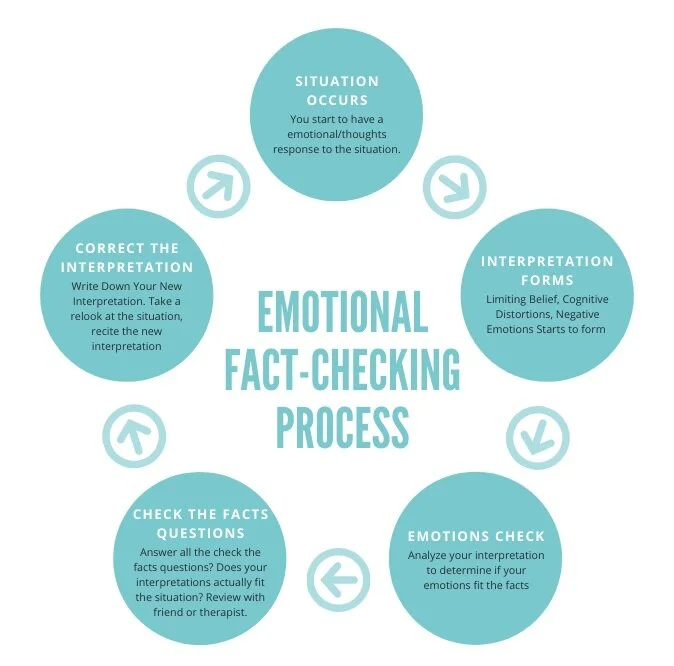
Fact-Checking Unhelpful Emotions
Module III | Session Three
Overview
M3 | Session Three: Fact-Checking Unhelpful Emotions
|
Defining Fact-Checking
Fact-Checking Our Interpretations
Fact vs Limiting Beliefs
Session Skill: Check The Facts
|
What Is Fact Checking?
Fact-checking is the process of verifying information... in order to determine its veracity and correctness. Ante hoc fact-checking aims to identify errors so that [facts] can be corrected before dissemination, or perhaps rejected. Post hoc fact-checking is most often followed by a written report of inaccuracies, sometimes with a visual metric.…
Source: Oxford University Press

Fact-Checking Our Interpretations
Last lesson, we learned that by influencing our interpretations, we can affect our emotions, which affects what we do.
Now, we’re going to learn a system to fact-check our interpretations to help make them as healthy and helpful as possible.
Our thoughts drive through our minds all the time. Like traffic, they might flow smoothly.
Sometimes, our thoughts can also back up, causing a “traffic jam”.
When they collide, the impact can truly throw us off psychologically—making us feel anxious, depressed, or generally distressed.
However, just because these thoughts are driving through your mind, it does not mean they represent an objective reality.
If we find that we spiral into limiting beliefs, cognitive distortions, and otherwise darker conclusions, we can enter a fact-checking process to ensure we are functioning with a fair assessment of reality.
Source: Psychology Today
Does Your Emotion Fit the Facts?
Intensity and duration of an emotion are justified by:
1. How likely it is that the expected outcomes will occur.
2. How great and/or important the outcomes are.
3. How effective the emotion is in your life now.
|
Fear
There is a threat to your life or that of someone you care about.
There is a threat to your health or that of someone you care about.
There is a threat to your well-being or that of someone you care about.
|
Anger
An important goal is blocked or a desired activity is prevented.
You or someone you care about is attacked or hurt by others.
You or someone you care about is insulted or threatened by others.
The integrity of you or your family is offended or threatened.
|
Disgust
Something you are in contact with could poison or contaminate you.
Somebody whom you deeply dislike is touching you or your family.
You are around a person or group whose behavior or thinking could seriously damage or harmfully affect you or your family.
|
Jealousy
1. A very important and desired relationship or object in your life is in danger of being damaged or lost.
2. Someone is threatening to take a valued relationship or object away from you.
|Guilt | Shame
You will be rejected by a person or group you care about if characteristics of yourself or of your behavior are made public.
Your own behavior violates your own values or moral code.
|
Source: Dialectical Behavioral Therapy Handbook
Session Skill
Check The Facts
Many emotions and actions are set off by our thoughts and interpretations of events, not by the events themselves. Our emotions can also have a big effect on our thoughts about events. Examining our thoughts and checking the facts can help us change our emotions.
Event → Thoughts → Emotions
Event → Emotion → Thoughts
Ask: What is the emotion I want to change?
List which of the primary emotions you are experiencing.
Ask: What is the event prompting my emotion?
Describe the facts that you observed through your senses.
Challenge judgments, absolutes, and black-and-white descriptions.
3.
Ask: What are my interpretations, thoughts, and assumptions about the event?
Think of other possible interpretations.
Practice looking at all sides of a situation and all points of view.
Test your interpretations and assumptions to see if they fit the facts.
4.
Ask: Am I assuming a threat?
Label the threat.
Assess the probability that the threatening event will really occur.
Think of as many other possible outcomes as you can.
5.
Ask: What’s the catastrophe?
Imagine the catastrophe really occurring.
Imagine coping well with a catastrophe (through problem solving, coping ahead, or radical acceptance).
6.
Ask: Does my emotion and/or its intensity fit the actual facts?
Check out facts that fit each emotion.
Ask Wise Mind.
Source: Dialectical Behavioral Therapy Handbook
